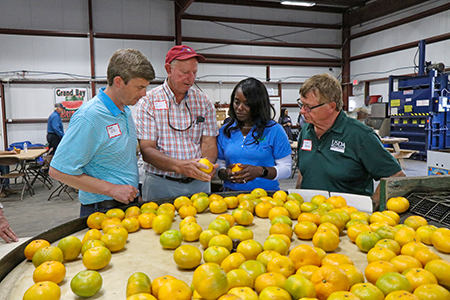USDA Risk Management Agency Administrator Tours Alabama Farms

Risk is an inherent part of any business — nowhere more so than farming. Crop insurance plays an increasingly important role in America’s agricultural economy as input costs escalate and profit margins narrow.
The administrator of the U.S. Department of Agriculture’s Risk Management Agency (RMA) was in Alabama recently and toured several nontraditional farms where crop insurance sometimes falls short.
RMA Administrator Martin Barbre said visiting oyster, satsuma, blueberry, kiwi and catfish farms in Alabama helped him more clearly understand the needs of those operations.
“I’m a corn and soybean producer from Illinois,” said Barbre, former president of the National Corn Growers Association. “I need to learn more about different crops across the country.
“One of the big things we’re working on is an aquaculture policy. I see where that could be useful to both oyster farmers and catfish farmers. We’ll be working with experts to make sure any new policy is actuarially sound and affordable and to make sure we are covering the right risks.”
Barbre toured a satsuma orchard on Art Sessions’ farm in Grand Bay where he saw ripening fruit that was days from harvest.
Sessions said crop insurance is available for the fruit, but coverage isn’t available for the trees.
“What would really hurt me and other satsuma and pecan farmers is if we had a disaster that wiped out our trees,” said Sessions, Mobile County Farmers Federation president. “We’ve got years invested in our trees, and an exceptionally hard freeze or a hurricane could destroy them. It would take decades to recover.”
Such high-value, dense agricultural crops are expensive to establish, but once established, they can be profitable, Sessions said.
“In one year, I can make as much off one mature satsuma tree as I can 3 acres of cotton,” he said. “But planting the trees, installing irrigation and waiting at least three years for them to produce enough fruit to harvest is expensive. And then there are annual costs of insect and fungus control, plus the labor costs to harvest the crop. The possibility of purchasing protection for the loss of our trees would be a great option.”
In addition to touring Sessions Farms, Barbre visited the Auburn University Shellfish Lab on Dauphin Island and oyster reefs near Bayou La Batre. He also visited Betty’s Berries in Wilmer; met with agricultural leaders at Auburn University and Tuskegee University; and toured Southeast Kiwi Farming Cooperative in Notasulga and Butch Wilson’s catfish farm in Browns.
Barbre, along with RMA Chief of Staff Keith Gray and other support personnel, also met with farmers and agribusiness professionals during a dinner at the Alabama Farmers Federation home office in Montgomery.
“It was an honor to have Administrator Barbre tour farms in Alabama,” said Federation National Affairs Director Mitt Walker. “He was genuinely interested in what farmers had to say about improving crop insurance programs to provide better protection for specialty crops. I appreciate that Administrator Barbre took time to actually meet with the farmers and look at their operations to better understand how his agency might be able to help them in the future.”
